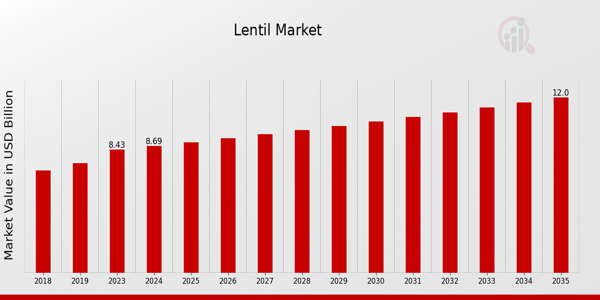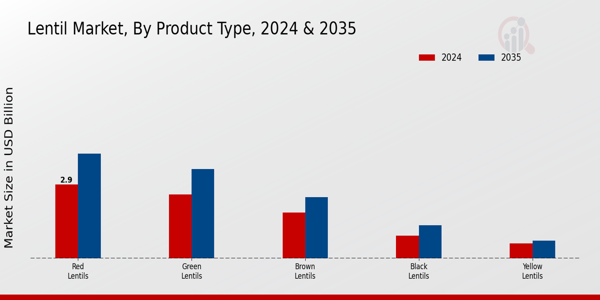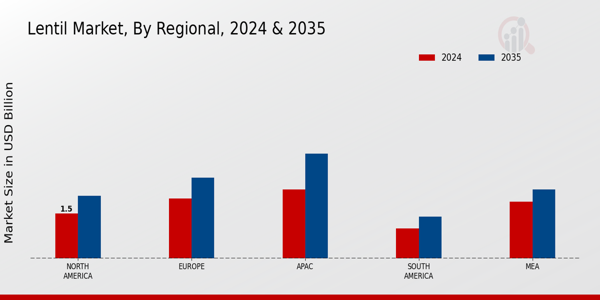Global Lentil Market Overview
Lentil Market Size was estimated at 8.43 (USD Billion) in 2023. The Lentil Incustry is expected to grow from 8.69 (USD Billion) in 2024 to 12.0 (USD Billion) by 2035. The Lentil Market CAGR (growth rate) is expected to be around 2.98% during the forecast period (2025 - 2035).

Key Lentil Market Trends Highlighted
Due to a move toward plant-based diets and growing consumer knowledge of the health advantages of lentils, the global lentil market is expanding significantly. Demand for lentils as a source of protein and vital elements has increased due to the growing popularity of vegetarian and vegan diets.
Furthermore, market expansion is supported by the increasing use of lentils in a variety of culinary applications, such as salads, soups, and side dishes.
Given that lentils are recognized to have a lower environmental impact than animal-based protein sources, sustainability issues are also quite important. Diversification and product innovation are examples of market opportunities.
Businesses might look into creating ready-to-eat meals and snacks made from lentils to satisfy busy customers looking for quick yet wholesome solutions. Adding extra vitamins and minerals to lentil products can also draw in health-conscious consumers. Furthermore, a possible growth path is entering emerging markets where dietary legume awareness is rising.
Recent trends indicating a preference for organic and non-GMO lentils are shaping the market landscape. Consumers are becoming more mindful of the source and quality of their food, which is prompting a shift towards ethically sourced lentils. E-commerce channels are also gaining traction, as online platforms provide easy access to diverse lentil products.
The focus on sustainability in agriculture is leading to improved cultivation practices, enhancing yield and quality. Overall, the future of the Global Lentil Market looks promising, with numerous opportunities for growth and adaptation to meet evolving consumer preferences.
Lentil Market Drivers
Rising Health Consciousness Among Consumers
The growing awareness of health and nutrition among consumers globally is a significant driver for the Global Lentil Market. Lentils are packed with essential nutrients, proteins, vitamins, and minerals, making them an ideal choice for health-conscious individuals.
As more people shift towards plant-based diets and seek out nutritious alternatives to meat, lentils have gained attention for their high protein content and low-fat characteristics.
This trend is particularly prevalent among vegetarians, vegans, and flexitarians, who are increasingly incorporating lentils into their diets to meet their nutritional needs while adhering to their dietary preferences. Moreover, lentils are rich in dietary fiber, which aids in digestion and helps maintain a healthy weight, further appealing to those interested in weight management.
Additionally, lentils are recognized for their potential to lower cholesterol levels and stabilize blood sugar, making them a favorable option for individuals with diabetes and heart-related issues.
As the demand for healthy food options continues to rise, the Global Lentil Market is well-positioned to benefit from this shift, resulting in lucrative opportunities for producers and retailers alike. The impact of health consciousness encompasses not only individual dietary choices but also fosters growth in the organic and natural food segments, ultimately promoting sustainable farming practices and advances in lentil production.
The expansion of health-focused products, such as lentil-based snacks and ready-to-eat meals, is further driving interest among consumers, contributing to the overall sustained market growth in this sector.
Increasing Demand for Plant-Based Proteins
With a significant shift toward plant-based diets, the Global Lentil Market benefits tremendously as lentils serve as a prime source of plant-based protein. This increasing consumer preference for sustainable protein sources is fueled by various factors, including environmental concerns, ethical considerations regarding animal farming, and the rising prevalence of lactose intolerance and other dietary restrictions.
The trend is backed by a growing body of research highlighting the advantages of lentils over meat, particularly in reducing carbon footprints and promoting biodiversity.
Additionally, lentils are gluten-free, which makes them a popular choice among consumers with gluten sensitivities or celiac disease. Consequently, the surging demand for plant-based proteins is catalyzing growth in the Global Lentil Market, with various segments actively seeking lentil products to incorporate into their offerings.
Growing International Trade and Export Opportunities
The expansion of international trade and increased export opportunities are greatly influencing the Global Lentil Market. Countries that produce lentils, notably Canada, India, and Australia, have recognized the global demand for lentils and are actively enhancing their export capabilities.
This growth in trade is supported by trade agreements and collaborations among nations, making lentils more accessible to different markets around the world.
As developing countries continue to show a growing appetite for nutritious food sources, lentils are emerging as a key export product. This expanding reach opens up new revenue streams for producers and contributes to the overall growth and stability of the Global Lentil Market.
Lentil Market Segment Insights:
Lentil Market Product Type Insights
The Global Lentil Market was poised for substantial growth, with a diverse range of product types that catered to various consumer preferences and dietary needs.
In 2024, the valuation of key product types reflected a robust demand, with Red Lentils commanding a notable market share at 2.9 USD Billion, which was indicative of their popularity owing to their quick cooking time and nutritional benefits.
Green Lentils, valued at 2.5 USD Billion, followed closely, appreciated for their earthy flavor and versatility in both culinary and health contexts, making them a staple in many households.
Meanwhile, Brown Lentils held a significant position in the market at 1.8 USD Billion, favored for their hearty texture and ability to retain shape during cooking, thereby widely used in various dishes such as soups and stews.
The Black Lentils, although smaller with a valuation of 0.9 USD Billion, gained traction as they were recognized for their high protein content and unique taste, contributing to their rising popularity among health-conscious consumers. Yellow Lentils, while valued at 0.59 USD Billion, were important for their distinctive use in specific regional cuisines and their easy digestibility.
This segmentation illustrated the Global Lentil Market's intricate landscape, characterized by a strong preference for specific types due to their culinary applications and health benefits. As the market continues to evolve, trends such as the increasing demand for plant-based proteins and gluten-free options will further bolster the relevance of these product types.
Consequently, the several types of lentils in the Global Lentil Market help drive market growth by appealing to a wide range of dietary preferences and nutritional needs, enhancing the sector's appeal and fostering competition among suppliers.
The data suggests considerable potential for all types of lentils to carve out a greater market presence in the coming years, given the growing consumer interest in nutritious and sustainable food alternatives. The steady acceptance of lentils in various forms, be it whole, in soups, or as flour-underscores, the versatility of this crop further establishes it as a crucial component in the Global Lentil Market.

Lentil Market End Use Insights
The Global Lentil Market showcases diverse opportunities across various end-use categories. The food industry plays a pivotal role, showcasing lentils as a staple protein source, crucial for meeting rising dietary demands and promoting health consciousness.
Animal feed accounts for a significant portion of the market, capitalizing on lentils' nutritional benefits for livestock, enhancing overall productivity and health. Nutraceuticals are also becoming increasingly important as consumers seek functional foods that support health, presenting growth potential within the health and wellness sectors.
The cosmetics and pharmaceutical sectors are gradually recognizing lentils' value for their antioxidant properties, leading to innovations in natural products. Understanding these dynamics within the Global Lentil Market segmentation remains essential for stakeholders aiming to navigate this evolving market landscape, supported by relevant Global Lentil Market statistics and data trends.
Various trends, such as the rising demand for plant-based food products and health supplements, further drive this market, although challenges like supply chain issues and fluctuating prices may impact overall growth.
Lentil Market Form Insights
The Global Lentil Market is structured around various forms, catering to diverse consumer preferences and culinary applications. Whole lentils serve as a staple in many diets, being rich in proteins and essential nutrients, making them a popular choice among health-conscious consumers. Split lentils also hold significant market appeal due to their quick cooking time and convenience, driving their popularity in various cuisines.
Additionally, lentil flour has gained traction as a gluten-free alternative for baking and cooking, appealing to the rapidly growing gluten-free segment. Furthermore, lentil snacks have emerged as a trendy option for health-focused consumers seeking nutritious snack alternatives. Meanwhile, lentil soups are celebrated for their comforting nature and nutritional benefits, further enhancing their standing in the market.
The segmentation within the Global Lentil Market reflects evolving consumer preferences, where each form provides unique advantages, contributing to the overall growth driven by trends toward plant-based diets and clean eating.
Lentil Market Distribution Channel Insights
The Distribution Channel segment of the Global Lentil Market is pivotal for reaching a diverse consumer base and plays a critical role in the overall market dynamics. Online Retail has emerged as a rapidly growing channel, catering to the increasing number of consumers preferring the convenience of online shopping.
Supermarkets continue to dominate the market due to their widespread presence and ability to offer a variety of brands under one roof, drawing in a significant number of shoppers.
Health Food Stores cater to health-conscious individuals, promoting lentils as a source of plant-based protein, which aligns with current consumer trends toward healthier eating habits. Meanwhile, Wholesale and Direct Sales channels are crucial for ensuring affordability and bulk purchasing options, appealing to both businesses and individual buyers alike.
Together, these channels contribute to enhancing the accessibility and availability of lentils, driven by increasing health awareness and changes in dietary preferences, thereby impacting the overall Global Lentil Market revenue and growth strategies.
Lentil Market Regional Insights
The Global Lentil Market was poised for steady growth across different regions, with North America, Europe, APAC, South America, and MEA contributing significantly to the market dynamics. In 2024, the North American market was valued at 1.5 USD Billion, reflecting its status as a notable player in the global arena, while Europe followed closely with a valuation of 2.0 USD Billion.
APAC emerged as a key region with a larger valuation of 2.3 USD Billion, driven by increasing health-conscious consumers and rising demand for plant-based proteins. South America, although smaller at 1.0 USD Billion, displayed potential for growth due to favorable agricultural conditions and shifting dietary preferences.
Meanwhile, MEA directed attention with a valuation of 1.89 USD Billion, driven by the region's growing interest in pulse crops for both nutritional benefits and agricultural sustainability.
The market growth in these regions was fueled by trends favoring vegetarian and vegan diets, an increasing shift towards sustainable farming practices, and the rising awareness of lentils' health benefits. Each region's distinct consumer preferences and agricultural practices played a pivotal role in shaping the Global Lentil Market segmentation and its overall dynamics.

Lentil Market Key Players and Competitive Insights:
The Global Lentil Market has witnessed significant growth and transformation in recent years, driven by changing consumer preferences towards healthy eating and plant-based diets. Competitive insights into this market reveal a dynamic landscape where various players strive to capture market share through innovation, sustainability practices, and strategic partnerships.
Factors such as regional production variances, evolving supply chain dynamics, and food processing advancements are contributing to the competitive environment. The market is characterized by both large-scale producers and smaller niche operators, each seeking to leverage their unique strengths to appeal to an ever-growing base of health-conscious consumers.
As demand continues to rise, companies find themselves under pressure to differentiate their products while maintaining competitive pricing, which has led to an increase in collaboration among industry players.
Cereals Canada is among the key participants in the Global Lentil Market, capitalizing on its strategic position within the agricultural supply chain. Known for its extensive network and relationships with growers, Cereals Canada effectively facilitates the promotion and export of high-quality lentils.
The company's commitment to research and development enables it to support farmers in enhancing lentil production through best practices and innovative farming techniques. Additionally, Cereals Canada engages actively in market development initiatives that open up new opportunities for lentil exports, significantly enhancing its market presence.
The company also excels in sustainability efforts, working diligently to develop practices that align with the growing consumer demand for environmentally friendly products, further strengthening its competitive position in the market.
Frontier Coop has established a solid presence in the Global Lentil Market by focusing on organic and sustainable food products. The company's commitment to sourcing high-quality lentils caters to the increasing consumer demand for organic options, presenting a competitive advantage.
Frontier Coop prioritizes relationships with farmers and producers, emphasizing fair trade principles and sustainability in its supply chain. This ethical approach not only boosts the quality of their lentil offerings but also resonates with environmentally conscious consumers who value transparency and responsibility in their food choices.
Frontier Coop's branding and marketing strategies effectively highlight these strengths, helping the company carve a niche in the competitive landscape of the lentil market while promoting a health-conscious lifestyle among its consumers.
Key Companies in the Lentil Market Include:
- Cereals Canada
- Frontier Coop
- Key Nutrients
- Legume Innovations
- Dalrymple Bay Coal Terminal
- Agrocorp International
- Oregon State University
- Harvest Innovations
- Horizon Ag
- The Chickpea Company
- Vegan Certified
- Rural Advancement Foundation International
- Sunrise Protein
- Canadian Special Crops Association
Lentil Market Developments
Recent developments in the Global Lentil Market have demonstrated notable activity, particularly among companies like Cereals Canada, Agrocorp International, and Horizon Ag, which have reported significant growth in product demand due to an increasing consumer shift towards plant-based diets.
These trends are bolstered by collaborations aimed at enhancing lentil supply chains, with operational expansions noted in key markets such as North America and Australia. Meanwhile, companies like Frontier Coop and Vegan Certified are focusing on sustainability initiatives, aligning with global concerns over food security and environmental impact.
Mergers and acquisitions have also been in focus, though recent activity linked to the specified companies remains limited, with no substantial deals publicly announced at this time. The rise in market valuation for businesses within the lentil sector is evident, as heightened interest in legumes is pushing prices upward and attracting investment.
Innovations in product formulations by Legume Innovations and Harvest Innovations aim to further tap into this growing market, indicating a strong future trajectory for lentil consumption on a global scale.
Lentil Market Segmentation Insights
Lentil Market Product Type Outlook
- Red Lentils
- Green Lentils
- Brown Lentils
- Black Lentils
- Yellow Lentils
Lentil Market End Use Outlook
- Food Industry
- Animal Feed
- Nutraceuticals
- Cosmetics
- Pharmaceuticals
Lentil Market Form Outlook
- Whole Lentils
- Split Lentils
- Lentil Flour
- Lentil Snacks
- Lentil Soup
Lentil Market Distribution Channel Outlook
- Online Retail
- Supermarkets
- Health Food Stores
- Wholesale
- Direct Sales
Lentil Market Regional Outlook
- North America
- Europe
- South America
- Asia Pacific
- Middle East and Africa
|
Report Attribute/Metric
|
Details
|
|
Market Size 2023
|
8.43(USD Billion)
|
|
Market Size 2024
|
8.69(USD Billion)
|
|
Market Size 2035
|
12.0(USD Billion)
|
|
Compound Annual Growth Rate (CAGR)
|
2.98% (2025 - 2035)
|
|
Report Coverage
|
Revenue Forecast, Competitive Landscape, Growth Factors, and Trends
|
|
Base Year
|
2024
|
|
Market Forecast Period
|
2025 - 2035
|
|
Historical Data
|
2019 - 2024
|
|
Market Forecast Units
|
USD Billion
|
|
Key Companies Profiled
|
Cereals Canada, Frontier Coop, Key Nutrients, Legume Innovations, Dalrymple Bay Coal Terminal, Agrocorp International, Oregon State University, Harvest Innovations, Horizon Ag, The Chickpea Company, Vegan Certified, Rural Advancement Foundation International, Sunrise Protein, Canadian Special Crops Association
|
|
Segments Covered
|
Product Type, End Use, Form, Distribution Channel, Regional
|
|
Key Market Opportunities
|
Rising demand for plant-based proteins, Increasing vegetarian and vegan population, Growing health consciousness among consumers, Expanding applications in food products, Enhanced agricultural technology and practices
|
|
Key Market Dynamics
|
growing health consciousness, increasing plant-based diets, sustainable farming practices, rising export opportunities
|
|
Countries Covered
|
North America, Europe, APAC, South America, MEA
|
Frequently Asked Questions (FAQ) :
The Global Lentil Market is expected to be valued at 8.69 USD Billion by the year 2024.
By the year 2035, the Global Lentil Market is projected to reach a valuation of 12.0 USD Billion.
The expected CAGR for the Global Lentil Market from 2025 to 2035 is 2.98%.
The APAC region is expected to have a significant market size of 2.3 USD Billion in the Global Lentil Market by 2024.
The market size for red lentils is projected to reach 4.1 USD Billion by the year 2035.
Key players in the Global Lentil Market include Cereals Canada, Frontier Coop, and Agrocorp International.
The estimated market size for green lentils is valued at 2.5 USD Billion by 2024.
The North American region is anticipated to grow from 1.5 USD Billion in 2024 to 2.1 USD Billion by 2035.
The market value attributed to brown lentils by 2035 is estimated to be 2.4 USD Billion.
The MEA region is expected to grow from 1.89 USD Billion in 2024 to 2.3 USD Billion by 2035.

















